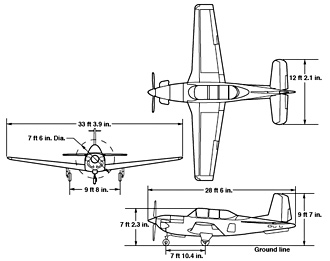- NASA Home
- | Centers
- | Dryden Home
- | News
- | Fact Sheets
Search Dryden
Fact Sheets
T-34C Mission Support Aircraft
03.08.07

Image above: NASA Dryden's T-34C mission support aircraft flies over Lake Isabella.
Mission support aircraft such as the T-34C accompany research flights for photography and video data collection, and also as safety chase. At Dryden, the T-34C is primarily used for chasing remotely piloted unmanned air vehicles which fly slower than NASA's F-18's mission support aircraft can fly. It is also used for required pilot proficiency flying.
In its role as a military trainer, the instructor pilot would ride in the back seat, while the student would be in the front seat. As a NASA mission support chase plane, the back seat would be occupied by a photographer or flight test engineer on research missions.
NASA Dryden has operated two T-34C aircraft. The first was previously flown at the Glenn Research Center in Cleveland, Ohio, for propulsion experiments involving turboprop engines, and then came to Dryden as a chase aircraft in 1996. That aircraft was returned to the U.S. Navy in 2002. Dryden obtained its second T-34C in early 2005 from the U.S. Navy's Air Warfare Center Aircraft Division at Naval Air Station Patuxent River, Md., where it was due to be retired.
Nicknamed the TurboMentor, the T-34C is an upgraded, turboprop-powered version of the earlier piston-engined T-34A and T-34B models that served as primary training aircraft for Navy and Marine Corps pilots for more than 40 years. Built by Beech Aircraft Co. (now Raytheon Aircraft), the T-34C shares the same basic wing planform and landing gear as the civilian Beechcraft Bonanza series of general aviation aircraft from which it was derived.
 Image above NASA Dryden's T-34C mission support aircraft 3 view with dimensions.
Image above NASA Dryden's T-34C mission support aircraft 3 view with dimensions.
Aircraft Statistics
Primary Function at NASA Dryden: Mission support, safety chase, pilot proficiency
Contractor: Raytheon Aircraft Company (formerly Beech Aircraft Co.)
Propulsion: Model PT6A-25 turbo-prop engine (Pratt & Whitney Aircraft of Canada), rated at 715 shp. torque-limited to 400 shp, driving a Hartzell three-blade constant-speed propeller 7 ft. 6 in. in diameter.
Wingspan: 33 feet 5 inches (10 meters)
Length: 28 feet 8 inches (9 meters)
Height: 9 feet 11 inches (3 meters)
Weight: 4,425 Lb. gross; 2,630 Lb. empty
Landing gear: Electrically operated retractable tricycle gear, hydraulic brakes.
Speed: Never exceed: 280 Knots (322 mph); Max. cruise 223 knots (257 mph) at 17,500 feet; Min: 60 knots (70 mph); stall 55 knots w/o flaps
Fuel capacity: 142 gallons
Max rate of climb: 1,690 feet /min at sea level. Ceiling: 30,000 Feet Range: Approximately 600 nautical miles at 200 knots cruising speed Crew: Two (pilot, flight test engineer or photographer)
Photo Collection